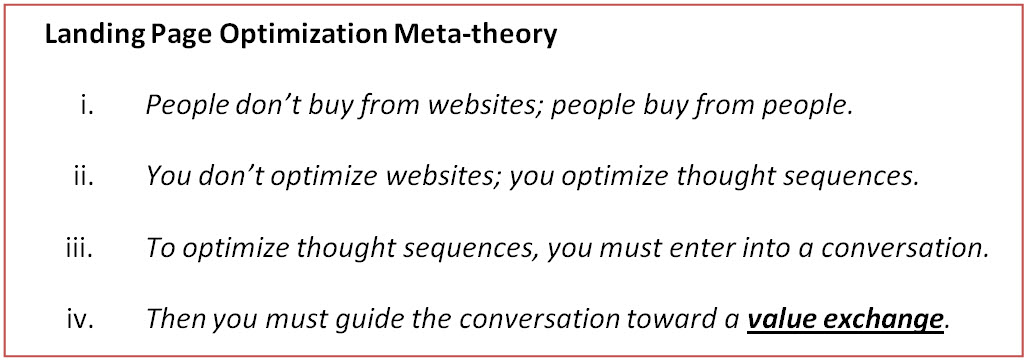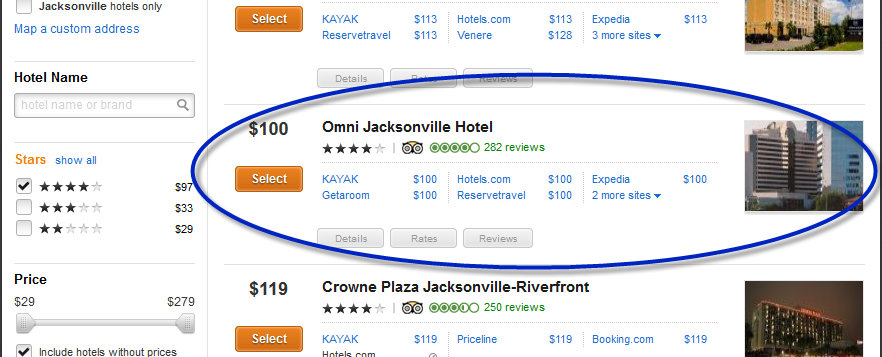As part of any value proposition, you must have an “only” factor. This means you must differentiate yourself from your competitors in at least one way. The two “only” factors that most commonly come to mind are price and quality. Price, especially, is often at the forefront of every consumer’s mind.
However, in some industries, the top competitors all compete on similar to identical pricing. You know it, your competitors know it and the consumers will know it after a little research.
So, what do you do when your price matches the other leading companies in your market?
First, you must determine another area where you outshine the rest of the pack outside the price arena. If not, as Flint McGlaughlin, Managing Director, MECLABS, says, “It’s likely that your value proposition is already going to be underperforming because it is not forceful enough.”
Second, you might consider hitting the price issue head on. Consumers compare prices – in this digital world, it’s a fact of life. With a few words in their browser search box, consumers can leave your website and find the prices of every competitor in your market.
Instead of letting them leave to find this information, you could present competitors’ prices right on your website. Some companies have already achieved success with this method of attack.
Progressive Insurance is a well-known example of this strategy. The company promotes its comparison shopping on its website, in its search marketing and in its television ads.
If you can’t see the benefits of providing competitors’ prices, let me share two specific advantages the MECLABS Optimization Team shared.
Benefit #1: Address a need in the buyer’s process
As part of any marketing strategy, you should know the steps your customers make in the buy process. Do they research companies, and then select a product from a selected company? Do they research products, determine the specific product they want, and then find the best deal on that product through price comparisons?
If it’s the latter, adding competitors’ prices to your site could be addressing a major need in your customer’s purchase cycle.
“Once they’re there, you’re answering all of their questions. You want to satisfy the perceived needs of the visitors to your site,” said Spencer Whiting, Senior Research Manager, MECLABS.
By providing a price comparison, you effectively solve one issue you know the customer will need addressed. Spencer said when looking at analytics for many Research Partners’ websites, the number one link visitors click on is often pricing.
Addressing this need also cuts back on potential anxiety around cost. In any economy, but especially today’s, people want to know they are getting the best value for their money. Cost can be a major source of anxiety for many buyers, so addressing this need and correcting that anxiety can help propel the potential customer through to the next stage of the buy process.
Benefit #2: Optimize the thought sequence
Presenting competitors’ pricing offers a second benefit: optimizing the thought sequence. You don’t want your website visitors to conduct unsupervised thinking.
In fact, this is part of the foundation of the MECLABS Landing Page Optimization Online Course.
The importance of thought sequences is described by the MECLABS LPO Meta-theory:
To optimize the thought sequence on your landing pages, you can make price part of the conversation. You want to steer the conversation toward a value exchange on your website.
“If you present competitor’s pricing on your site, you have much more control over the perceived cost and value of your product compared to others,” said Lauren Maki, Optimization Manager, MECLABS.
So by showing the similar pricing, you have established an equal perceived cost into the value exchange. As for the value of the product, as Lauren mentioned, you will want to refer back to that “only” factor you have included in your value proposition.
She went on to provide an example using cellular service carriers, “If you have a product for $100 and your competitor has a comparable product for $100, the cost/price is equal, so the visitor is left to decide which has the best value. This is where you want to have influence on the visitor’s perception. ‘Yes, they’re equal in price, but with [our product], you get the fastest and largest network – something you don’t get with the other brand. ”
Having communicated the answer to any questions about potentially better pricing the customer might have as well as providing evidence of a better value for that same perceived cost, you are preventing them from searching for the answer on their own – and off your site.
The below example is Omni Jacksonville Hotel’s listing on KAYAK. You can see how KAYAK, an online travel company, controls the thought sequence of its visitors.
By providing its pricing side by side with its competitors, KAYAK opens a conversation about pricing. Travel is an industry where consumers can easily find the best deals through a little Google research. So in opening the conversation right in the search results, KAYAK uses that opportunity to guide the conversation toward its value exchange.
As in the search result example above, when all the pricing is the same, what do you think the consumer will do? If the customer is simply looking for the best price because they already decided to stay at the Omni Jacksonville Hotel, they’ll likely click on that eye-catching, orange call-to-action button, “Select.”
What about when you do not have the lower price?
Some marketers might wonder about the instances of where you don’t beat or match on price. Well, for a site like KAYAK, it can’t worry about the results that show pricing where competitors beat it. Even if the travel site didn’t show the better competitor pricing, the customer could still very easily find those prices on other sites. Those are likely lost conversions whether the site gives the customers that knowledge first-hand, or not.
In this case, a statement showing the value customers receive by paying more could also be helpful, to showing them why they should buy from you. After all, a dollar sign doesn’t signify the only cost in a purchase. For example, KAYAK could provide a statement about saving time by booking through its all-in-one travel search engine.
However, by consistently providing competitor pricing, even when you aren’t on top, you create an ongoing conversation based on trusted information. The next time that customer is looking for a flight, DVD, electrical part or any other product, they’ll know they can rely on you to provide them with the location of the best deal. In turn, you hope every time you do come out on top or match other competitors, they’ll convert with you since they’ll already be on your site and you have provided that “only” factor to cement the value of your product.
Final thought
Spencer had this final insight: “Always test it to make sure it works.”
As with any element on your website, you can’t know how your audience will respond without testing. You may find presenting competitor pricing works better further down the buy cycle. Or maybe mentions within the copy – e.g., “We match any price” – will work better than side-by-side price comparison tables.
You won’t know until you try, so if your company matches major competitors on pricing, test it out and see how your audience responds.
Related Resources:
E-commerce: Manufacturer’s revamped website strategy leads to 26.3% lift in sales
Value Proposition: A simple spreadsheet to help you categorize your products’ value
Is Your Company Embracing ‘Fear-Based’ or ‘Fear-Less’ Marketing in 2012 and Beyond?
Competitive Messaging: Tell your customers what you can’t do







Very very good article!
I think that could be a great opportunity but in several countries you can’t put explicitly competitor’s prices.
I love the idea of doing the pricing research for your visitor so they don’t have to. This can also help to eliminate tyre kickers and remove the focus from price to what is the overall value of your product or service compared to competitors.
Excellent article. Every time I come back to this website, I get some gem that changes how I think about how I perceive and think about my own website. Thank you for taking the time to go through such helpful information.
Hi Selena,
I like the idea of mentioning the competitor’s price on a website as it will be beneficial for your potential customers and it will create a good image on customers mind. All in all it will maximize the chances of trade from your website.